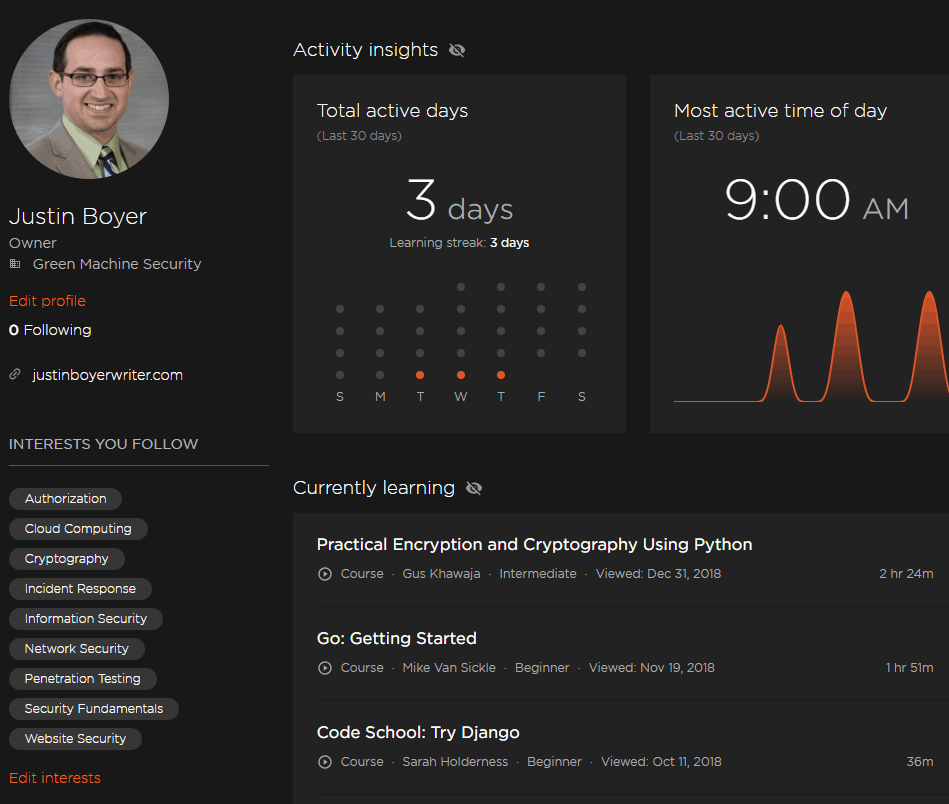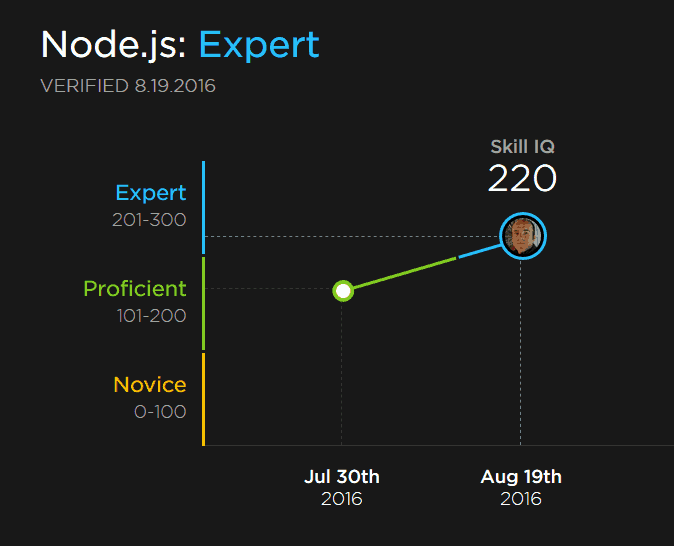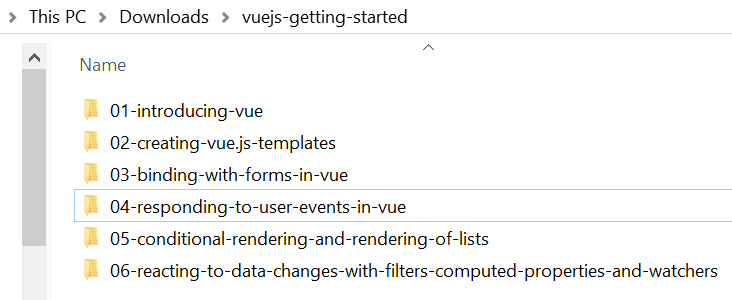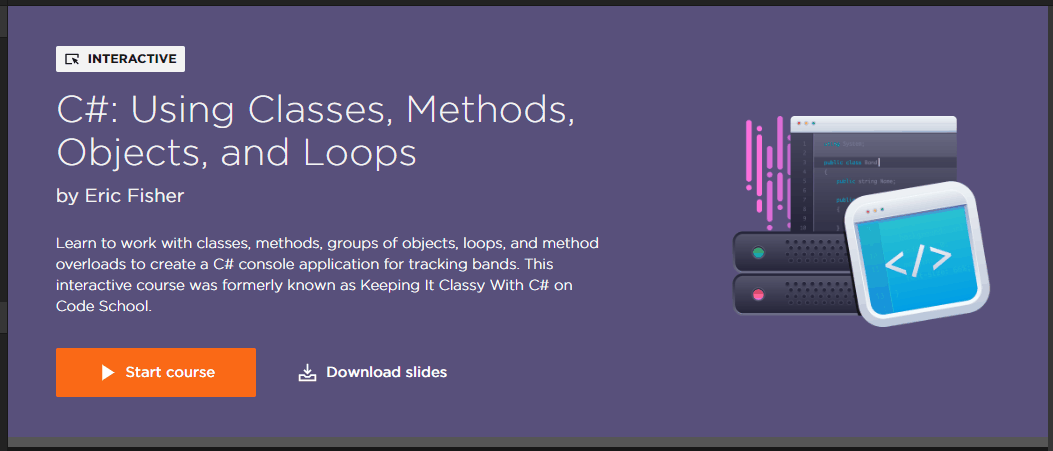This guide is a collaboration between Contributors Kevin O'Shaughnessy and Justin Boyer.
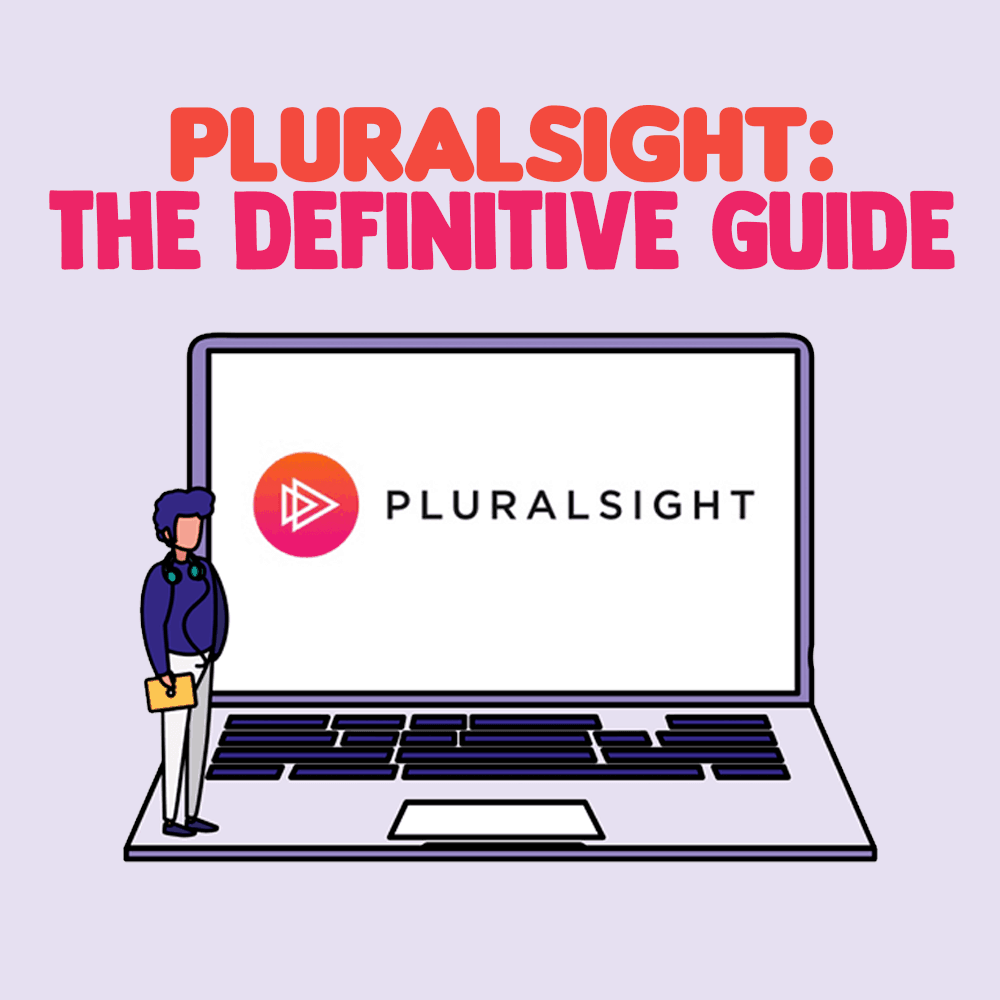 We’ve all been there.
We’ve all been there.
Lost in the technological shuffle of day-to-day life in software development. New technologies and frameworks appear all the time. New versions of existing technologies make sweeping changes. And programmers have to keep up with the shifting sands.
Even if you aren’t chasing the latest development fads, there is still complexity in diving deeper into a particular topic. For example, once you know the basics of Node.js, how do you take your skills to the next level? How do you build the expertise necessary to advance your development career?
Wouldn’t it be great to have a tool at your disposal that holds thousands of courses on almost every topic a programmer would need to know? And what about organizing the courses in a logical order so you can have a concrete plan to advance your career?
The above tool does exist. It’s called Pluralsight. Welcome to this review of Pluralsight, where we explain its various advantages and how it can give you an edge in your IT career.
And how do we know Pluralsight so well?
Kevin O’Shaughnessy strongly believes in continuous learning and has completed 429 courses and 11 learning paths since discovering Pluralsight in 2012.
Justin Boyer is the author of the Pluralsight courses Performing Threat Modeling with the Microsoft Threat Modeling Methodology and Practical Cryptography in Node.js. He’s a serial learner himself, discovering Pluralsight in 2011 and driving its adoption at two companies before becoming an author.
What Is Pluralsight?
Pluralsight is an online learning platform for professionals, especially technology professionals. It began as a training company providing classroom training for companies. Over time, the focus has shifted to online training in topics ranging from software development to marketing and graphic design. As more companies look to provide on-demand video training for their employees, Pluralsight has risen to meet the need.
Pluralsight has continued to grow and now offers assessments to help measure learners’ growth in various skills and tools for companies to keep track of what their employees are learning and what they should learn next.
Pluralsight is not only for employers and employees. Individual user plans allow anyone to learn new technologies. Freelancers can learn more skills to help better serve their clients. If you’re looking to move up in your career as a software developer, use Pluralsight to learn new technologies and skills that’ll get you there. A Pluralsight subscription will benefit anyone looking to stay ahead of the technology curve and learn new skills.
Pluralsight pioneered a crowdsourced training model. Instead of hiring full-time trainers to build the online courses, Pluralsight accepts courses created by industry experts. The experts, upon being accepted as Pluralsight authors, create courses in their specialty and then collect royalties based on the performance of their courses. Pluralsight saves on the overhead of a large team of trainers, and the authors make a little side income. Not a bad arrangement.
Pluralsight’s growth has continued steadily over the years. Its library consists of over 7,000 courses authored by over 1,500 industry experts. Pluralsight holds a large tech conference, Pluralsight LIVE, in its hometown of Salt Lake City, Utah, every year. It launched its IPO last year and looks forward to continued growth.
What Topics Does Pluralsight Cover?
Pluralsight offers training in all the major languages and technologies.
As the Pluralsight library has grown into thousands of courses, the training material has been categorized into four main types of users:
Software Development
There are thousands of courses aimed at developers of all skill levels. Major areas of study here are the popular languages Python, JavaScript, Java, and C#, as well as web development and mobile development.
IT Ops
These are courses aimed at professional or aspiring database and system administrators. They cover diverse areas such as IT certifications, cloud platforms, networking, security, database administration, virtualization, and servers.
Data Professional
These courses are on data science topics, including business intelligence and big data. The major relational database engines, Oracle and SQL Server, are heavily covered.
Information and Cyber Security
These are courses for both IT security professionals and students wanting to enter this field. It includes huge amounts of material that will assist you in gaining professional certifications such as CompTIA.
How Much Does It Cost? (Different Packages and Options)
Standard deals for individuals are $35 per month or $299 annually.
There are also packages available for businesses wanting to offer their staff Pluralsight training.
Microsoft Developer Network (MSDN) subscribers get free access to Pluralsight for up to three months. It amazes me how many MSDN subscribers are not making use of this offer; if you already have an MSDN subscription, set up your free Pluralsight account today.
Why Not Just Use Free Services?
Many other video sharing platforms offer free tutorials, YouTube and Vimeo being the most famous of these. There are good-quality videos on the free services but also many poor-quality videos, and it is easy to waste time searching for the better ones among all the others.
Most authors on free platforms produce the content entirely on their own. With paid subscription services such as Pluralsight, full-time professionals help the author edit the video to get it to a higher level of production. Authors learn how to shoot professional video and must audition, and every clip is reviewed by an editor and peer reviewed to make sure it’s effective. Pluralsight’s editors focus not only on quality but also on the effectiveness of teaching.
Free services often require you to watch advertisements to fund the site. Pluralsight is 100 percent ad-free and even allows for downloading courses onto your mobile device via their app. You can take Pluralsight training with you on a plane, train, or automobile.
When you use free services, you’re not guaranteed to learn from an expert. With Pluralsight, only the best teachers in the industry make it as authors. About a quarter of applicants who make it to the audition phase of the application process are accepted as authors. Therefore, you know you’re getting training from an exclusive club of those currently working in the industry, with the necessary experience and teaching ability.
Profiles
Pluralsight gives you a profile page, allowing you to easily share your progress with your friends and colleagues. The profile page shows the courses you’re currently working through, the ones you’ve completed, and the interests you’ve shown.
Users have access to bookmarks and channels to save and organize their favorite courses. Channels can be shared with others or made public and are a great tool for teams to organize the courses they need for new hires or continuing education.
Assessments
Pluralsight offers assessments of your knowledge of more than 100 different skill areas.
The new Role IQ feature measures what you know about a topic (like Node.js) and tells you which courses you should take next.
Each assessment results in a score between 1 and 300, which is categorized as either Novice, Proficient, or Expert level. If you choose to retake an assessment, the skill IQ history feature can show how much your knowledge has increased over time.
Downloads
In addition to the videos, you can download slides, code, and other course materials. These are zip files and have the contents structured according to the relevant course module. As an example, the Vue JS Getting Started course contains slides for all six modules.
Famous Authors
Many of the Pluralsight authors are world famous and among the best developers in the world. Here is just a small selection of famous names and faces.
Scott Hanselman
If you Google “Scott,” you’ll see Scott Hanselman’s page come up close to the top of the first page. Scott has earned this level of renown by blogging, podcasting, writing open source software, and giving conference speeches for more than a decade.
Scott has four courses available on Pluralsight, including the excellent and entirely free course Get Involved!, which offers expert advice on blogging, Twitter, GitHub, Stack Overflow, user groups, and conferences.
Scott’s courses were originally produced with Rob Conery for Tekpub, and Pluralsight bought the rights to them and acquired Tekpub in 2014.
Troy Hunt
Troy Hunt is a Microsoft regional director and MVP for developer security. He’s been building web software since the very early days of the web and created Have I been pwned? a free service that aggregates data breaches and helps people establish potential impacts from malicious web activity.
Troy is the author of the e-book and series OWASP Top 10 for .NET Developers and creator of the Automated Security Analyser for ASP.NET Websites. He blogs regularly and is a frequent speaker at industry conferences and throughout the media.
At the time of writing, Troy has produced 47 courses for Pluralsight. These cover many information security topics, including Angular JS, and other topics such as JavaScript, denial of service, SQL Injection, and HTTPS. He also teaches courses on GDPR and Azure.
John Sonmez

Julie Lerman
Programmer and mentor for 30 years, Julie is the leading independent authority on the Entity Framework and has been using and teaching it since its inception.
Author of three Entity Framework books, including the Code First and DbContext editions, Julie is well-known in the .NET community as a Microsoft regional director and MVP, and international conference speaker. She has authored the monthly MSDN Magazine Data Points column since 2010.
Julie Lerman has produced 22 courses with Pluralsight.
Douglas Crockford
Douglas Crockford is famous for his excellent book, JavaScript: The Good Parts, published in 2008. Modestly described by Crockford as “a cranky little pamphlet about JavaScript,” this book taught a generation of developers that there is a hidden beauty to the JavaScript language, and this popularized the language and accelerated its rise to become the world’s most widely used language today. His most recent book is How JavaScript Works.
Douglas invented the world’s most popular data format, JSON, and he started the trend for improving the quality of JavaScript code with the aid of linting tools in 2002 by creating JS Lint.
Douglas is a senior JavaScript architect at PayPal, and produced the 10-hourlong course Good Parts of JavaScript and the Web during a three-day workshop for Frontend Masters, which is also available on Pluralsight.
John Papa

He has produced 40 courses for Pluralsight, covering topics such as Angular, ASP.NET, iOS, TypeScript, build automation, and Docker.
[blank_space height='3em']
Jon Skeet
Jon is the highest-rated user on Stack Overflow with over 34,500 answers at the time of writing. He is especially known for his detailed knowledge of C#, wrote the book C# in Depth, and is a Microsoft MVP. He is also highly skilled in the Java language.
Jon is featured in seven courses on Pluralsight.
[blank_space height='3em']
What Types of Courses Will You Find on Pluralsight?
Play by Play
Play by Play videos demonstrate live programming and discussion sessions. Play by Play courses often feature two authors at once discussing a topic on screen, unrehearsed and unscripted. Sometimes it’s a discussion, other times it’s working through a problem or implementing a project.
A great example is the course Play by Play: OWASP Top Ten 2017. In this course, Troy Hunt discusses the OWASP Top Ten web application vulnerabilities with Andrew van der Stock, who sits on the board of directors for OWASP. The insight gained into the new vulnerabilities on the list and the methodology on how they were chosen is invaluable and can’t be found anywhere else.
Executive Summary Courses
These courses are kept short and sweet: Typically they are under 30 minutes in length, do not require much prerequisite technical knowledge, and do not burden you with a lot of technical detail. They aim to give you a heads-up on the most essential information of topics like GDPR.
Executive summary courses are built for busy C-level or department heads who don’t have much time to deep dive into a topic. They’re structured like a conversation between friends or if an executive came and asked you what cloud computing is—simple illustrations and practical application so the executive can be prepared to make decisions when the topic comes up.
Fundamentals Courses
These courses are beginner-friendly in that they do not assume previous experience but also go deep into the topics and emphasize the computer science concepts behind the technologies.
Advanced Courses
These courses are most suitable for users who have some existing knowledge or experience with a topic and are interested in gaining more advanced knowledge.
Advanced courses, sometimes titled as “In-Depth,” are courses built to deep dive into a particular topic. This isn’t a broad fundamentals course but rather a tightly focused course on one aspect.
For example, an Angular fundamentals course will teach you everything you need to know to build an Angular application. An advanced course may deep dive into how Angular services work and best practices in creating them.
Big Picture Courses
These courses aim for breadth rather than depth. Typically only lasting an hour or two, these courses help you to assess whether or not the topic is one that you want to invest more serious amounts of time to master.
Interactive Courses
Interactive courses, also referred to as “hands-on learning” courses, are designed to provide an interactive medium for learning a programming language or technique.
The student is able to watch an instructional video and then practice the concepts by writing real code right in the browser. The interactive portion walks students through building a real application using the concepts taught in the course.
Interactive courses are a new offering from Pluralsight, so the interactive library is continuing to grow to include more topics.
Frontend Masters
Frontend Masters is a series of filmed workshops given live to students by many of the world’s leading experts in the art and science of front end web development. For the students who physically attend, the workshops typically take one to three days. But for online students, the workshops are edited down into courses that last between two and 10 hours.
Pluralsight has licensed some of the courses that are produced by Frontend Masters (there are 27 available at the time of writing). For access to the entire list of Frontend Masters courses, you will need to purchase a subscription.
Learning Paths
A single Pluralsight course can transform your understanding of a topic, but if you are really serious about mastering a technical area, you might decide to complete an entire learning path.
Learning paths allow you to go from absolute beginner to expert in many different fields. There are more than 100 different learning paths available for you to choose from.
Learning paths are a set of courses that split into three categories: beginner, intermediate, and advanced.
Using the Role IQ assessment, you can quickly ascertain your level of understanding of a topic relative to other Pluralsight users. Based on these results, Pluralsight will advise you on whether to start with beginner courses or whether to skip them and start with intermediate or even advanced courses. It is of course entirely up to you which courses you decide to watch, but the recommendation system can help you find the level that is most appropriate for you.
Contribute Your Expertise: How To Become an Author
As you begin to consume Pluralsight courses and learn more about your favorite topics, you may begin to wonder how you can contribute. Perhaps your area of expertise isn’t yet represented in Pluralsight’s library. How do you contribute your expertise and become a Pluralsight author?
First, there are different ways to contribute. You can create video-based courses that teach a specific topic. These courses make up much of Pluralsight’s content.
You can also help to create assessments that measure the knowledge a student has on a particular topic. These later become the Role IQ tests within the learning paths.
Finally, you can build technical guides, which lead the reader through a process of accomplishing a technical task. Technical guides typically focus on one specific task and walk the reader through accomplishing it.
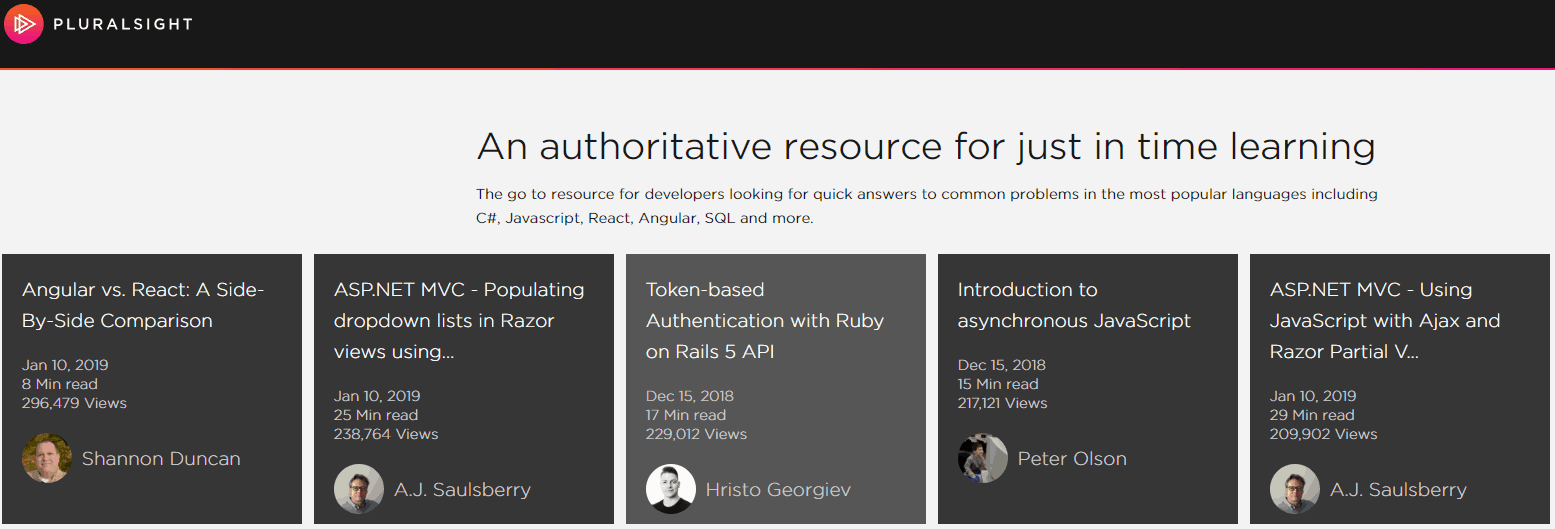
The first step to becoming an author is to fill out the form found on the Become a Pluralsight Author page. Those who offer unique experience and who could help with needed topics are contacted by a member of Pluralsight’s acquisitions team.
Prospective authors are required to audition before they are accepted. The audition is simply a minilesson in the style of a Pluralsight course on a topic of the prospective author’s choosing. Once submitted, the clip is reviewed for teaching effectiveness foremost. Teaching effectively online is a key skill every author must possess. The requirements are stringent in order to make sure content is of a very high quality. About a quarter of those who get to the audition phase are accepted as authors.
The best part of being a Pluralsight author is the amazing support you receive. Pluralsight knows its authors are very important to their success. Every author is assigned an author success manager, who is your point of contact and guides you through the process of making a course. Pluralsight also has a website specifically built for authors, providing resources around course creation, equipment, tips and tricks, and even branded icons and webpages authors can use to make their courses look great without building from scratch.
If you are an expert in any technical niche and enjoy teaching others, go ahead and apply to become an author. You can reach many people with your expertise and make a real impact on their lives. I recently received a message on LinkedIn from someone who used one of my courses to help pass a security certification exam. Nothing feels quite like seeing someone succeed because of your efforts.
Getting Your Money’s Worth: Make It a Habit
Pluralsight subscriptions are all-you-can-eat types of deals: You can watch as much or as little as you wish. Another metaphor is the gym membership. If you are tempted to try a Pluralsight subscription, we want you to get the maximum value out of your financial investment. To accomplish this, you also need to make a significant time investment in Pluralsight. But this does not need to be onerous; learning with Pluralsight can be easy and fun.
You can learn with Pluralsight on the bus or the train, with the Pluralsight app for Android and iOS. Let’s suppose that you have a one-hour journey to and from work by public transport. That gives you two hours per day to learn something new. In just one or two days, you could go from zero to hero.
You don’t need to worry about slow streaming speeds or your data allowance being exceeded: You can download an entire course from your home Wi-Fi to your phone and then watch it offline whenever you have some free time.
Or you could watch Pluralsight while eating your lunch. Many courses are short enough to be completed within your lunch hour, and even more are broken down into sections that each last less than an hour, allowing you to easily complete the course within your working week.
Whether you were previously watching on a desktop, laptop, or phone, your profile allows you to continue exactly from where you left before. Pluralsight also makes it easy for you to make your own notes as you learn.
As you find your skill levels improving, learning becomes easier, and your profile will make it easier for you to get noticed by and impress other tech companies. Hard work pays off, but if you plan yourself an hour or even just a few minutes each day for learning something that you have an interest in, it will never feel like hard work.
Many employers also allow or encourage their employees to spend time watching Pluralsight courses. The cost of Pluralsight training is typically much less than on-site training, so it is an effective way for them to keep their employees’ technology skills up to date.
If your current employer doesn’t offer any form of technical training, they could be losing out to other companies that do, both when it comes to hiring power and employees leaving for companies offering better training. So your boss might just agree with you that purchasing a business plan could make financial sense.
Tips and Tricks
Pluralsight has many features built to help you learn the way you learn and to provide the best learning experience possible. Let’s look at some tips and tricks that’ll make your Pluralsight experience even better.
Variable Playback Speed
The most important feature for effective studying and use of your time is the variable playback speed. The software includes time stretching, so the pitch remains the same even at double speed. Play around with different speeds until you find the quickest speed that you are comfortable with. Don’t play it so fast that you have trouble understanding the author, but do play it a step faster if you have no difficulty understanding.
Closed Captioning
Most Pluralsight courses include captions. Being able to read the information at the same time as hearing it can reinforce the message in your mind. If English is not your first language, you can display it in any language Google Translate supports.
Note Taking
The act of note taking can help you understand the course material. When reading a book, you must always read it line by line. Videos, on the other hand, continue playing whether you are concentrating or not, and it is easy to miss a lot of important information if you aren’t paying attention.
The process of writing notes helps keep you engaged and avoid distractions. Jason Alba has some more useful tips on eliminating distractions in his Becoming a Better Listener course.
Pluralsight has its own facility for saving your notes online and automatically linking them with the clip that you were watching at the time you took them. Simply type into the textbox and press “enter” to save. If you want to create separate paragraphs, press “shift” and “enter” twice before typing your next paragraph.
You can enter multiple notes, which are automatically linked with the video clip and the moment in time on the video clip that you entered them for. When you do enter more than one note for the same point in time in a video clip, the video progress bar displays with a notes icon and the number of notes you have entered. If you enter notes at different points in the clip, a note icon is shown for each relevant point in the clip.
Entering multiple notes for each video clip can help you structure the information that you are learning. Short video clips emphasize one key point, and in those situations, a single note will capture the essence of the clip. Longer video clips feature much more information, and so it requires more effort to retain that extra information, but by breaking up the video clip into one short note for each key point you have learned from the video clip, it becomes much easier to remember what you learned in the future.
Sometimes a complex concept cannot be explained simply in just a few words but can be done so with a table, diagram, or illustration. Pluralsight uses illustrations wherever they are most effective. In these cases, instead of writing reams of notes, you can simply mark the point in the course that contains a useful visual.
You can also download all the notes that you’ve written for a course to a CSV file.
The CSV file separates the information into the following categories:
- Note
- Course
- Module
- Clip
- Time in Clip
- URL
Here is an example:
"Note","Course","Module","Clip","Time in Clip","URL" "Helps you maintain separation between your design and data","Vue.js: Getting Started","Creating Vue.js Templates","Binding to CSS Classes","0:11","https://app.pluralsight.com/player?course=vuejs-getting-started&author=chad-campbell&name=vuejs-getting-started-m2&clip=14&mode=live&start=11.475537¬eid=a5d8c25f-e7ad-4a51-8302-1a7d7f01b1c1"
Using this information, when revising what you have learned you can quickly jump back to the video clip of interest and edit your notes as you please.
The only slight disadvantage with the note-taking feature is that because note entries are made in a standard HTML textbox, it doesn’t offer you word auto-completion. If you use a tool such as NotePad++ or Visual Studio Code, you can write notes faster and then paste those notes into the Pluralsight notes facility.
Learn It, Do It, Teach It
Remember that passing the course, or the learning path, isn’t really the end of your learning—just the end of the first chapter in your journey to true expertise. It should give you the confidence to try it yourself and experiment, and then teach it to someone else.

